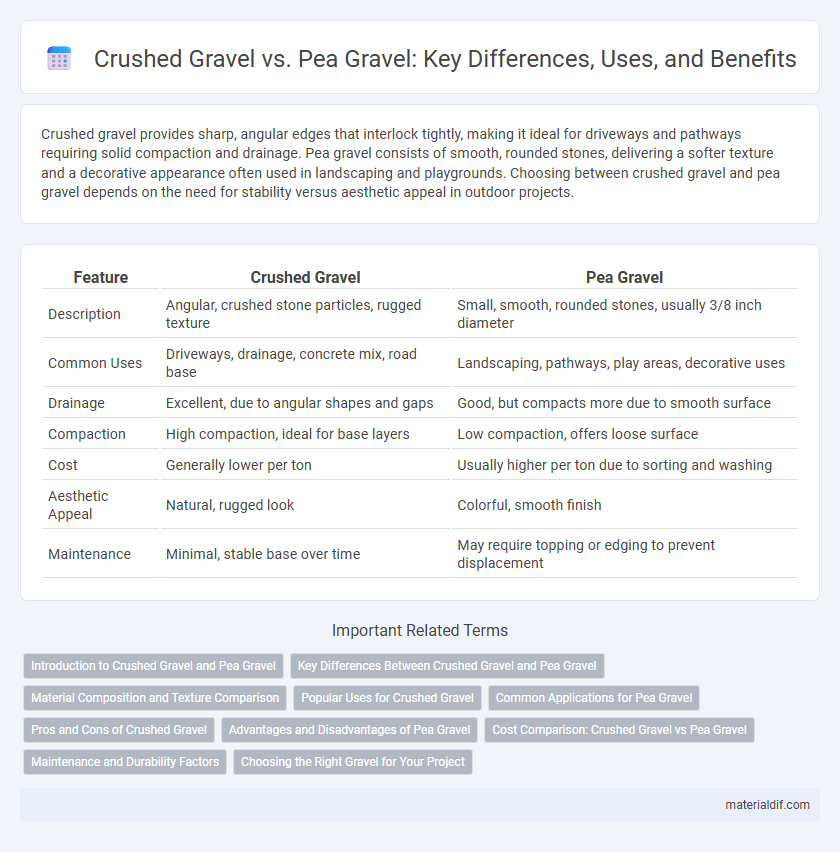Crushed gravel provides sharp, angular edges that interlock tightly, making it ideal for driveways and pathways requiring solid compaction and drainage. Pea gravel consists of smooth, rounded stones, delivering a softer texture and a decorative appearance often used in landscaping and playgrounds. Choosing between crushed gravel and pea gravel depends on the need for stability versus aesthetic appeal in outdoor projects.
Table of Comparison
| Feature | Crushed Gravel | Pea Gravel |
|---|---|---|
| Description | Angular, crushed stone particles, rugged texture | Small, smooth, rounded stones, usually 3/8 inch diameter |
| Common Uses | Driveways, drainage, concrete mix, road base | Landscaping, pathways, play areas, decorative uses |
| Drainage | Excellent, due to angular shapes and gaps | Good, but compacts more due to smooth surface |
| Compaction | High compaction, ideal for base layers | Low compaction, offers loose surface |
| Cost | Generally lower per ton | Usually higher per ton due to sorting and washing |
| Aesthetic Appeal | Natural, rugged look | Colorful, smooth finish |
| Maintenance | Minimal, stable base over time | May require topping or edging to prevent displacement |
Introduction to Crushed Gravel and Pea Gravel
Crushed gravel consists of angular, broken rock pieces typically ranging from 3/8 to 1 inch in size, making it ideal for driveways and construction projects requiring strong compaction. Pea gravel features smooth, rounded stones about 1/4 to 1/2 inch in diameter, commonly used in landscaping and decorative pathways for its natural appearance and comfortable texture. Differences in shape and size influence drainage, stability, and aesthetic applications, guiding the choice between crushed gravel and pea gravel.
Key Differences Between Crushed Gravel and Pea Gravel
Crushed gravel consists of angular, sharp-edged stones that provide excellent compaction and stability, making it ideal for driveways and construction bases. Pea gravel features smooth, rounded stones typically about 1/4 inch to 3/8 inch in diameter, offering a decorative, softer appearance often used in landscaping and pathways. The primary differences lie in texture, shape, and application, with crushed gravel favored for functionality and pea gravel for aesthetics.
Material Composition and Texture Comparison
Crushed gravel consists of mechanically broken stones, providing angular edges and a coarse texture, which enhances compaction and stability for construction projects. Pea gravel is composed of naturally rounded, smooth stones, generally smaller in size with a polished surface, making it ideal for decorative landscaping and pathways. The angular shape of crushed gravel increases interlocking capabilities, while the rounded texture of pea gravel offers better drainage and a softer feel underfoot.
Popular Uses for Crushed Gravel
Crushed gravel is commonly used for driveways, walkways, and drainage systems due to its angular edges, which allow it to compact tightly and provide a stable foundation. It is favored for construction projects requiring strong support and durability, such as road bases and retaining walls. Its excellent load-bearing capacity makes it ideal for heavy-duty applications compared to rounded pea gravel.
Common Applications for Pea Gravel
Pea gravel is commonly used in landscaping projects such as garden pathways, patios, and playground surfaces due to its smooth texture and small, rounded stones that provide excellent drainage and comfort underfoot. It also serves as an effective decorative mulch in flower beds and around trees, helping to retain soil moisture and prevent weed growth. Its non-abrasive quality makes pea gravel ideal for water features and driveways where a softer surface is preferred over sharper crushed gravel.
Pros and Cons of Crushed Gravel
Crushed gravel offers superior compaction and stability, making it ideal for driveways and construction projects requiring solid foundations. Its angular shape provides better interlocking properties, reducing shifting and erosion over time. However, crushed gravel can be more abrasive and uncomfortable for barefoot walking compared to smoother pea gravel.
Advantages and Disadvantages of Pea Gravel
Pea gravel offers excellent drainage and a smooth texture, making it ideal for walkways and landscaping projects where comfort and aesthetics are priorities. Its small, rounded stones reduce compaction and provide a natural appearance but can shift easily, requiring frequent maintenance or edging to keep materials contained. Unlike crushed gravel, pea gravel is less suitable for high-traffic or heavy load areas due to its loose, unstable nature.
Cost Comparison: Crushed Gravel vs Pea Gravel
Crushed gravel typically costs between $15 and $40 per ton, offering a budget-friendly option for driveways and landscaping projects. Pea gravel, priced around $30 to $45 per ton, tends to be more expensive due to its smoother texture and aesthetic appeal. Choosing between the two depends on project requirements and desired appearance, with crushed gravel being more economical for large-scale use.
Maintenance and Durability Factors
Crushed gravel offers superior durability due to its angular edges, which lock together to provide a stable, long-lasting surface requiring minimal maintenance. Pea gravel, characterized by its smooth, rounded stones, tends to shift and wash away more easily, necessitating frequent replenishment and upkeep. Maintenance costs for crushed gravel remain lower over time, making it ideal for driveways and high-traffic areas where durability is essential.
Choosing the Right Gravel for Your Project
Crushed gravel features sharp, angular edges that provide excellent compaction and stability, making it ideal for driveways, walkways, and drainage systems where a solid base is essential. Pea gravel consists of smooth, rounded stones typically ranging from 1/8 to 3/8 inch in size, offering better aesthetics and comfort for patios, garden paths, and playgrounds due to its softer texture. Selecting the right gravel depends on project requirements such as structural support, drainage needs, and desired appearance, with crushed gravel favored for durability and pea gravel chosen for decorative purposes.
Crushed gravel vs Pea gravel Infographic

 materialdif.com
materialdif.com